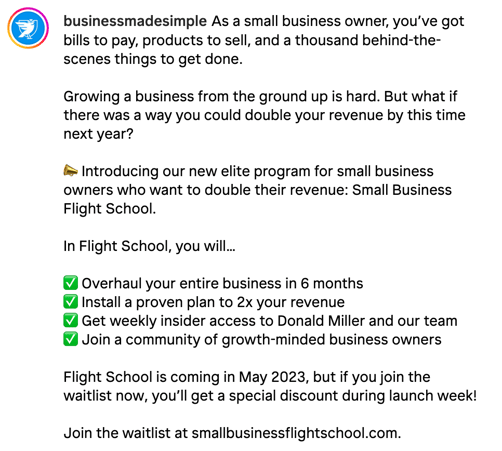How to Use the Power of Story to Write a Great Social Media Post
Published: Apr 19, 2024
Creating compelling social media posts often feels like tons of work for little reward.
You might sink hours into trying to edit a video (only to scrap the entire thing), or maybe you avoid social media altogether because you don't have time or you haven't gotten results.
It's easy to wonder if all the effort is even worth it. After all, with so much content already out there, making your posts stand out is a real challenge.
But here’s the good news!
There's a simple 5-step social media post formula that can change the game for you and help you knock out a fantastic social post in a matter of minutes. And more importantly, a post that actually helps grow your business.
This formula is rooted in storytelling and will help you create posts that catch people’s attention and encourage them to engage with your brand. It turns the hair-raising task of content creation into something more straightforward, predictable, and effective.
Using the power of stories, you can connect with your audience in a meaningful way. This leads them from casually scoping out your business to taking action—whether that’s buying your product, signing up for your email list, or snagging tickets to your upcoming event.
Not sure exactly what story your brand should be telling? Learn how to create a BrandScript and break through the writer's block you feel whenever you write a social media caption.
Now, let's walk through the 5 steps of the formula so you can start implementing it right now in your business’s social media accounts.
Step 1: Identify a Problem
The first thing you want to do when drafting a new post is pinpoint a problem that resonates with your audience. Try tapping into the challenges or frustrations they face daily.
By starting with a problem, you're not just selling a product or service—you're offering a solution to something that genuinely affects their lives.
Let’s say you’re writing a post for a football team, the Tennessee Titans. Instead of merely announcing a game, imagine a post that begins with a problem:
"Have Sundays gotten a little boring for your family?"
This line directly addresses a common issue—boredom and a lack of engaging family activities on a weekend. It's a problem many can relate to, setting the stage for a post that not only captures attention but also piques interest in what comes next.
By identifying a problem first, you're doing more than just talking at your audience. You're talking to them. You're acknowledging their experiences and setting yourself up as someone who understands and has a solution. It's the difference between a post that gets scrolled past and one that stops someone in their tracks, making them think, "Wow, yeah, that's exactly how I feel!"
Step 2: Make the problem worse (emotional)
Once you've identified a problem, the next step is to agitate it and make it feel even bigger. You want to show them how the problem affects them more deeply than they might have thought. The goal is to make the issue feel important, so they really start looking for a way to fix it.
Let's keep going with our example for the Titans. We started with, "Hey, you know, Sunday has gotten a little boring for the family." To make the problem feel bigger, you could say:
"Every weekend ends up feeling like the same old, same old, and no one can escape the Sunday scaries."
This makes the problem of boring Sundays feel even worse. It's not just about being bored once. It's about feeling that boredom every single week, and losing precious weekend joy to a looming sense of monotony and dread. It shows how this problem isn't just annoying—it's something that takes away from the fun and excitement families should be having together on weekends.
Step 3: Talk about how the problem gets solved
Now that everyone feels the weight of the problem, it's time to show them there's a light at the end of the tunnel. This is where you bring in your solution.
Remember, your solution should directly tackle the problem you've talked about and give people a reason to get excited.
Sticking with our Titans example, after talking about how Sundays have become a drag, we can brighten things up:
“But what would it look like to actually make Sunday the most exciting day of the week? That can easily happen when you take your family to a Titans football game.”
Here, we're saying that watching the Titans play is the perfect answer to the problem of dull Sundays. We're promising something that will shake up their routine in the best way possible, making every game an event that brings the family together for excitement and joy.
By offering this solution, we flip the script from focusing on the problem to showing how much better things can be. It's about letting your audience know that there's a way to beat their boredom and make Sundays something to look forward to again, all thanks to what you're offering.
Step 4: Talk about what life looks like after the problem gets solved
Now that we've talked about how to fix the problem, let's paint the picture of what life looks like when everything gets better. This part is all about dreaming up the good times that come from choosing your solution.
With our Titans example, we've already suggested turning boring Sundays into fun game days. Next, we might say:
“We've got great tickets for you and your family so you can scream your heads off and make memories that last a lifetime.“
It’s a clear, specific visual image of a great Sunday their kids will love. Simple, easy, effective.
By talking about this positive change, you're not selling a ticket anymore. You're offering a way to make life more fun. It becomes about giving families a reason to look forward to Sundays again, making them eager to jump at the chance for such a great time. This step makes it clear why taking action is worth it, helping your audience see the joy they can have.
Step 5: End with a strong call to action (CTA)
Finally, it's time to seal the deal. This is where you use a Call to Action (CTA) to tell your audience exactly what they need to do next.
A strong CTA is direct, clear, and compelling—it makes taking the next step irresistible.
For our Titans example, we've set the stage for a solution to boring Sundays with the promise of exciting game days. Now, we encourage action:
"Click the link in our bio and get your tickets today. The kids will think you're the best and so will the Titans!"
This CTA is straightforward and taps into a powerful motivator: making their kids happy. It's not just about buying tickets. It's about becoming a hero in their kids' eyes.
This final step is crucial because it bridges the gap between wanting and having, between imagining and experiencing. The CTA is your way of saying, "Here's how to make it happen."
Putting It All Together
Writing a social media post that grabs people's attention and gets them to take action doesn’t have to be a stressful dog and pony show. By following this simple, narrative-driven formula, you can transform a basic promotion into a compelling story that captures attention and motivates your audience.
Let's see how the formula comes together in our Titans example:
“Have Sundays gotten a little boring for your family? Every Sunday ends up feeling the same, doesn't it? The weekend excitement just turns into the same old, same old. But what would it look like to actually make Sunday the most exciting day of the week? That can easily happen when you take your family to a Titans football game. We've got great tickets for you and your family so you can scream your heads off and make memories that last a lifetime. Click the link in our bio and get your tickets today. The kids will think you're the best and so will the Titans!”
Here's another example of an effective Instagram post from Business Made Simple's account:

So there you have it! A simple way to make your social media posts do more than just share news.
By talking about a common problem, making it feel big, showing off a fun solution, and then telling your audience exactly what they can do about it, you're not just “posting”—you're storytelling.
A great social media post is all about connecting with your audience and giving them a reason to get excited. So next time you're about to make a post, think about how you can turn it into a story that gets everyone ready to jump into action!
